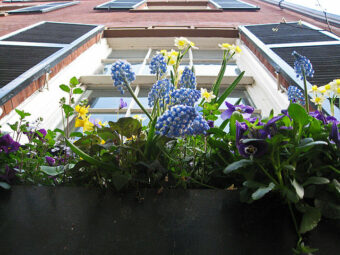In this article, we will be discussing how to create a stunning window box display in a simple plastic box. Who does not like a stunning display of plants under a window, where they can be admired every time you look out or every time you look up from outside?

When you are going for an impactful window box display use short stocky plants and compact trailing plants, as they do not too big and eventually cut out the light.
As it will be often neglected, it is a good idea to choose drought-tolerant plants. This is advised as they do not hold much compost, will be exposed to strong winds and will be exposed to bright sunlight, all causing the compost to dry out quickly.
This is why herbs will do well and will provide some welcome food, especially as you do not have to water frequently.
WHAT PLANTS CAN BE USED
They are many attractive plants noted for their leaves and make excellent subjects in containers, be it colourful leaves or variegated forms. Combine these with colourful and attractive bedding plants and tender perennials.
In these plastic window boxes, many interesting displays can be made by mixing the round shapes of pelargoniums and pansies with upright rosemary along with low mounds of golden oregano.

Other plants that go with shrubby herbs and provide an attractive foil to flowers include Lavender, Hyssop, Helichrysum italicum (the curry plant), and Santolina chamaecyparissus (Cotton Lavender). Use these with silver-leaved Artemisias and Salvias (Sage), especially with the highly decorative Salvia officinalis ‘Icterina’ that has gold variegated leaves and Salvia officinilis ‘Purpurascens’ (the Purple Sage).
In the front use low growing alternatives to oregano, where Chamaemelum nobile ‘Flore Pleno’ the double-flowered Chamomile comes into their own. It has creamy pompon flowers and feathery foliage along with the sweet scent when disturbed goes well with Thymus x citriodorus ‘Aureus’, the garden creeping lemon thyme.
Other plants that associate with herbs well include scented-leaved pelargoniums and mesembryanthemum.
To soften the front edges of the trough plant at each Portulacas and Sedum spathulifolium.
CREATING A SIMPLY WINDOW BOX DISPLAY
First, but a plastic through that is self-watering as it is best not to water so often. Make sure that it has a perforated base plate that separates the plants from the reservoir below. This should be regularly topped up with water.

Near the top of the plate at the bottom of it drill some 3mm holes to stop the plant from being overwatered and allow the excess to seep away.
Place the base plate in the plastic trough and then cover them with a good quality multipurpose compost, it is also a good idea for drought-resistant plants to add a good handful of horticultural grit. This will help with the drainage.
At the back of the plastic trough plant a row of geraniums, one at each end and one in the centre. Remove any leaves that are yellowing or dead and nip out the growing tip, as this will encourage new shoots and for the plant to bush out.
Between the geranium (Pelargonium, Century Series Orchid Types) interplant with two miniature rosemaries (Salvia rosmarinus ‘Miss Jessop’s Upright). If the herb grown is too thin, trim the growing tip to encourage it to bush out.
SOFTEN THE EDGES
To soften the front edge of the trough, plant at even spaced, 5 golden oreganos (Origanum vulgare ‘Aureum’). Gently squeeze each root ball into an oval shape to allow the pansies room to be grown in.
Between each Oregano add sparkle by using a cream coloured pansy. Fill the gaps between the front and back of the trough, it is best to use as many pansies as you can fit in. This will not only complete the display but give subtle undertones to your window box display.
Keep the display in a wooden window box, where the manufacture has been described in a previous article, in a brightly lit spot where it will need to be fed, watered and deadheaded regularly. Pinch the rosemary shoot regularly to keep the growth compact.
CREATING A DIASCIA DISPLAY IN A CLASSIC STYLE TROUGH
First, in a plastic container trough, create some drainage water by drilling holes in them by using a 3mm drill bit or if you do not have one, you can use an awl.

To the bottom of the trough, add gravel to a depth of 2.5cm and then cover this with a good quality multipurpose compost allowing it all to settle.
Water it and then add 3 Diascias in a row along the back. Use a plant like Diascia ‘Salmon Supreme’. In the front at each corner and in the centre plant Plecostachys serpyllifolia that will trail over the edges. In between the Plecostachys plant Lotus berthelotii.
The complete display will simply look stunning and elegant and will suit in front of most window displays.
CONCLUSIONS
In this article, we have discovered how to create a simple but elegant window display. Two displays have been given; one based on Pelargoniums, rosemary, Oregano and Pansies to make one impactful display. Another display for a more classical look is based on a mix of Diascias, Lotuses and Plecostachys.
This will suit any window boxes that you have in mind and they will certainly improve the looks of your window.
I often think that it is a shame that a lot of homes do not use the vacant space beneath windows to display a wide array and displays of plants. It is so often ignored but I feel the tide is turning and with these designs shown in this article, we may see more homes with window boxes.
If you want to make your neighbours green with envy, why not try a design suggested in this article.
If you have any comments or questions on creating a window box display that you wish to make, please do so in the comment box below.
Happy window box creating.
